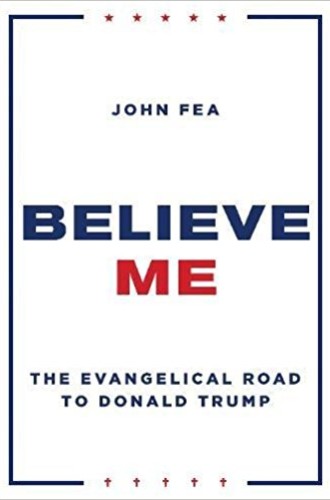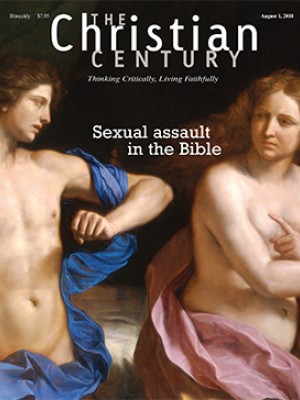The first step, we often hear, is admitting you have a problem. For a broad group of American evangelical thinkers who might be characterized as other-than-lockstep Republicans, the confession part has never been much of a challenge. The real problem is getting anyone to join them in penance. Since the heyday of the Moral Majority, evangelical progressives and quite a few centrists too have called out their fellow believers for conflating God with the GOP. Nearly 40 years since Ronald Reagan wooed the nascent Christian right on his way to the revolution, this dynamic remains strikingly unchanged.
The current twist is that the voting majority of evangelical America apparently has mistaken Donald Trump for a God-fearing man. “As a historian studying religion and politics, I should have seen this coming,” admits John Fea in his timely and compelling study of the hastily arranged but profoundly impactful exchange of vows between Trump and evangelicalism. We can debate whether Trump’s win was a fluke, but white evangelical support for him in the general election was not.
Read our latest issue or browse back issues.
If Trumpism represents merely the latest scandal in evangelical politics, though, Trump is an extreme case. The tabloid capitalist is the least convincingly Christian president of our times, or at least the most outlandish one. His predecessors in the White House, many of whom also knew a thing or two about dissembling and philandering, generally still could guess when they were sinning. Trump has openly wondered why he would possibly need to ask God for forgiveness. Yet this cradle Presbyterian who never left the nursery has proved an adept fisher of born-again voters. Not unlike most historians and pollsters of evangelicalism (not to mention most Americans who actually are familiar with the word), Trump had in mind a broad subset of white Americans when as a candidate he spoke awkwardly of “the evangelicals.” The Republican nominee netted an estimated 81 percent of evangelical votes on his way to an electoral college victory.
Lest readers have any doubt where Fea will come down on evangelicals’ support for Trump, the Messiah College professor clues them in before page 1, dedicating the book to “the 19 percent.” Trump often urges listeners to “Believe me,” appending the imperative to any number of points by way of deflecting attention from the evidence. Taking that line as his title, Fea explains why so many evangelicals do believe Trump, then urges them to put their faith in more lasting things.
Fea is uncommonly well positioned to make the case for turning away from the Donald and toward the Almighty. A prolific author and a nonstop blogger, he is the very definition of an engaged Christian scholar. Fea has a knack, not always evident among his like-minded peers, for negotiating the spheres of faith and the academy without making a big deal out of the occasional tension between them. He seems comfortable in his evangelical shoes. That might make him appealing to secular editors and publishers who like to identify evangelicals who defy stereotypes. Yet one senses that Fea would happily sacrifice any such attention if only evangelicals, including his brothers and sisters at the megachurch he has long attended, would abandon their self-defeating quest for a Christian America.
Fea’s explanation of the 81 percent is primarily historical in nature, as one would expect, although the evidence he marshals suggests there might well be something singularly sirenic about Trump himself. Candidate Trump bellowed all the right notes, especially regarding fear, which is Fea’s major explanatory theme. Evangelical fear is the kind of thing that disqualifies Barack Obama on account of his unconventional presidential narrative (black, academic, urban, religiously liberal) while turning his successor, whose résumé made him both unconventional and unqualified, into a refreshing outsider who tells it like it is. Obama’s progressivism, coupled with heightened concerns about religious liberty and a sharpened focus on the Supreme Court, created space for a wordmonger who would say anything to get a massive bloc of votes. Sure, Trump is a racist adulterer whose dueling life conceits are unpaid bills and unsavory associations—but his middle name is not Hussein.
Stepping back from the headlines for a chapter, Fea offers a sprawling, mostly coherent overview of evangelical fear politics over time, from witch trials to apologetics for slavery and eventually to the libel that the first black president is a Muslim. Fea’s search for context contrasts with Trump’s callous attitude toward the very past that he so often manipulates. The president, Fea writes, has an “inability to understand himself as part of a larger American story.” Trump looks in the mirror and sees only himself. But he quickly figured out what had been keeping many evangelicals up at night since November 2008.
While Fea makes an intriguing case for the deep historical continuity evident in Trump’s seemingly exceptional antics, the most obvious antecedent for Christian Trumpism is fairly recent: the late 1970s rise of what used to be called the New Christian Right. It is now simply the Christian right, and Trump is the latest great white hope. He is the Christian right reductio ad absurdum. His born-again genuflectors are but the latest example of what Fea calls “court evangelicals.” This group includes First Baptist Dallas pastor Robert Jeffress, whose ideal president is “the meanest, toughest son of a gun I can find,” as well as evangelical dauphins Franklin Graham and Jerry Falwell Jr., who offer frequent reminders of the worst tendencies of their more famous fathers. For them, the fundamentals are flexible when a Republican is in the White House.
Meanwhile, the president’s allies within the Independent Network Charismatic movement have a fuller array of tools at their disposal to make Trump rhyme with scripture. Some liken the president to the Persian king Cyrus, a secular strongman who allowed God’s chosen to rebuild Jerusalem (where Trump relocated the U.S. embassy in Israel). Proponents of the prosperity gospel, including televangelist and reported Trump Tower condo owner Paula White (who may be the closest thing Trump has to a spiritual mentor), “seem like the kind of people that Trump would not only immediately like, but the kind he would love to have with him in The Apprentice boardroom.” Like Trump, they are performers who place a cash value on success.
The relative weakness of both Trump and his court evangelicals is what drove them together in the first place. Trump, as he never tires of saying, began as an underdog candidate. Once on top, Fea argues, Trump realized he “would need to find his evangelical groove” in order to stay there. By this time, the Christian right could no longer plausibly claim to speak for the moral majority. Rather than retreat from the culture wars, they turned to what Fea brands “the most immoral candidate in recent memory.” Now, because Trump has never been a majority president, and because his only discernible political standard is loyalty, the court evangelicals have notable access (notable even compared to what they had in the George W. Bush years) to the man on top.
Fea is a reflexively irenic writer who aspires to be gracious even when lowering the boom on the evangelical status quo. In a chapter on the “again” portion of “Make America Great Again,” he assumes the role of the patient Sunday school leader, skillfully explaining (as he has done elsewhere) why America both is and is not a Christian nation. The United States was and still is predominantly Christian, he concedes, but attempts by figures like David Barton to turn Thomas Jefferson into the Church Lady are bunk.
While such balance is commendable, Fea might have been more candid regarding the sort of matters that evangelicals typically cite when explaining why they vote Republican. His default move is to note that evangelicals have little to show for their persistent focus on social issues like abortion and gay rights.
Still, the upshot of this critique remains fuzzy. Fea plausibly argues that the reversal of Roe v. Wade would not mean the wholesale end of legalized abortion in America. So does that mean pro-lifers should go ahead and accept the legality of first-trimester abortions? Fea leaves the impression that he would say no, but he also implies that abortion need not be a political priority. On gay rights, his point about same-sex marriage is that it is a fait accompli. Where he stands remains unclear.
It is understandable if Fea does not want to risk further alienating his evangelical readers. After all, he has already highlighted how Trump is so obviously not one of them. Still, there is an assertive case to be made that a robust secular state—of the kind Obama sought—can function within a racially and religiously pluralistic nation without imperiling Bible-believing Christians. Making that case would require taking on the evangelical impulse toward antiliberalism. It would require a clearer statement that the use of public resources to address poverty and other issues of social justice is not a net threat to religious liberty. If more theologically conservative Christians had supported the basic idea behind the Affordable Care Act—that government can be an effective guarantor of access to health care for all Americans—then the issue of religious exemptions might have been more easily resolved. Anyway, if there is a Leviathan looming out there, it is more likely to be found in the West Wing than in a health coverage mandate.
Fea’s preferred alternative to the evangelical politics of fear is the civil rights movement. Yet he obscures that movement’s deep connections to American progressive politics. This might be a strategic move on his part, but it leads to curious and misleading assertions. “It is nonsensical,” Fea contends, “to talk about the civil rights movement in terms of political power,” because civil rights activists did not have much of it. They valued “humility, not power.” Perhaps they valued both.
True, Martin Luther King Jr. did not aspire to kiss the ring (even though he had his chances). But he did want to effect good policy. For example, King took to the pages of the Nation magazine to call for dramatic federal intervention to redress racial and economic injustices—that is, to move the powers that be in his direction.
“It is doubtful that Donald Trump knows or cares much about the debate over whether the United States is a Christian nation,” Fea opines toward the end of the book. So what does Donald Trump care about? Fea, like countless other observers (this reviewer included), is not always sure, save for the clear and present links between Trump’s political instincts and deep-seated racialized resentments. When tossing around slogans like “America First,” Trump swats away the historical spirits he is summoning. But as Fea’s book shows, those demons of the past help to explain the 81 percent.
Trump’s appeal to evangelicals may well end up being “a kind of Pickett’s Charge . . . to win the culture wars,” as Fea speculates. It might go down in the annals as the suicidal coda to an era when evangelicals tried to take back America at precisely the same time when much of the rest of nation was losing its religion (or practicing a different one). Or, if Trumpism endures, historians might one day explain how what used to be called American evangelicalism turned into a wholly owned subsidiary of Fear, Inc.
For the time being, though, the Trump presidency is a first things moment for all American Christians. It is a test of what we care most about—of who we choose to believe. Will the evangelicals answer Fea’s call to conscience? One of Trump’s favorite teases is “We’ll see what happens.” We shall see, indeed.
A version of this article appears in the print edition under the title “The 81 percent.”






